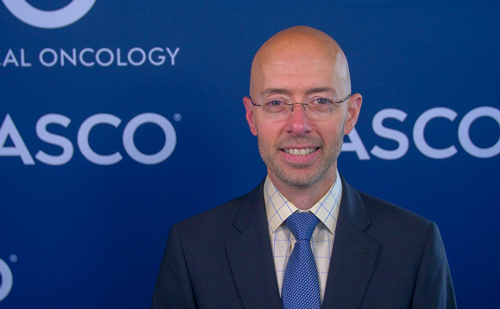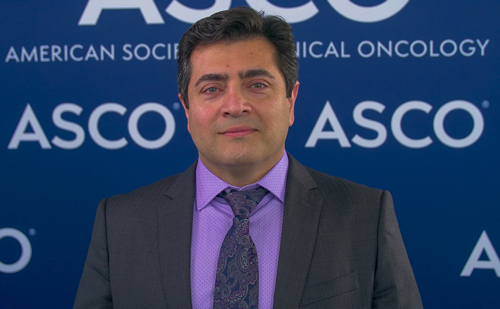Despite significant advances in diagnosis and treatment, renal cell carcinoma (RCC) remains one of the most lethal cancers. Worldwide, it is the 6th most commonly diagnosed malignancy in men and the 10th in women, and accounted for 5% and 3% of all cancer diagnoses in 2018.1 Although RCC is curable if treated at an early stage, the prognosis for metastatic disease is dismal, with 5-year survival of only 12%.2 Since the mid‐2000s, the treatment of metastatic RCC has undergone a paradigm shift from non‐specific therapy with broad‐acting cytokines to specific regimens, which directly target the cancer, the tumour microenvironment, or both. The first generation of immune checkpoint inhibitors (anti-cytotoxic T-lymphocyte-associated protein 4 [CTLA-4] and anti-programmed cell death protein 1 [PD-1]/its ligand [PD-L1]) led to unprecedented outcomes in patients with metastatic disease.3 However, these agents are effective in only a minority of patients, therefore, newer strategies are targeting additional immunomodulatory mechanisms to activate the patient’s own anti-tumour immune responses. Immunotherapy in RCC was a hot topic at the ASCO 2019 Genitourinary Cancers Symposium, which was held on 14–16 February 2019 in San Francisco, California, USA.
One of the most attractive treatment approaches for advanced clear cell RCC is combined therapy involving immune checkpoint inhibitors and therapies targeting angiogenesis, particularly axitinib (Inlyta®, Pfizer, New York, New York, USA), a vascular endothelial growth factor (VEGF) targeted agent. The results of the JAVELIN Renal 101 trial were presented at ASCO GU and simultaneously published in the New England Journal of Medicine .4 The study involved 886 patients with previously untreated, advanced RCC who were randomised to a combination of avelumab (Bavencio®, Merck, Kenilworth, New Jersey, USA) plus axitinib or sunitinib (Sutent®, Pfizer, New York, New York, USA) alone. Among the 560 patients with PD-L1-positive tumours the median progression-free survival (PFS) was 13.8 months in the combined therapy group and 7.2 months in patients receiving sunitinb. Similar findings were seen in the overall population; 13.8 months versus 8.4 months. The overall response rate (ORR) was 52%. Overall survival (OS) data are not yet mature. A subgroup analysis showed that the benefits were seen in all of the International Metastatic Renal Cell Carcinoma Database Consortium risk group (i.e. favourable, intermediate, and poor risk). Adverse events (AEs) during treatment occurred in 99.5% of patients in the avelumab plus axitinib group, and in 99.3% of patients in the sunitinib group; these were grade 3 or higher in 71.2% and 71.5% of the patients in the two groups, respectively.4
Another study investigating the combination of immune checkpoint inhibitors and axitinib, the open label phase III KEYNOTE-426 study, showed impressive findings, which were also simultaneously published in the New England Journal of Medicine. 5 In this study, 861 patients with previously untreated, advanced RCC who were randomised to a combination of pembrolizumab (Keytruda®, Merck, Kenilworth, New Jersey, USA) plus axitinib or sunitinib alone. At a median follow-up of 12.8 months, combination therapy was associated with a 47% reduction in the risk of death compared with sunitinib; the 12-month OS rate was 89.9% in the combination group versus 78.3% in the sunitinib group and median PFS was 15.1 months with the combination regime versus 11.1 months with sunitinib. The ORR was 59.3% in the pembrolizumab-axitinib group and 35.7% in the sunitinib group. These benefits were seen irrespective of risk group or PD-L1 status. Serious treatment-related AEs were seen in 62.9% of patients in the combination therapy group compared to 58.1% who received sunitinib; these led to discontinuation of all treatment in 8.2% versus 10.1% of the two groups, respectively.5 This is the first study to show an improvement in OS, PFS and ORR in an unselected front-line metastatic RCC population.
The KEYNOTE-426 data appear to be superior to those from JAVELIN-101. However, both are practice-changing studies and support alterations in the first-line treatment recommendations for RCC. It is likely that combined regimens will become the new standard of care for advanced clear cell RCC.
The first prospective data of immune checkpoint inhibition monotherapy in non-clear cell RCCs were also presented.6 Non-clear cell RCC is a heterogenous group of malignancies representing 15–20% of metastatic RCC.7 It comprises a number of subtypes (papillary, chromophobe, medullary, collecting duct, translocation, and unclassified), and is often excluded from clinical trials, making treatment challenging.7 In the phase II KEYNOTE-427 (cohort B) study, 165 patients with non-clear cell RCC and no prior systemic therapy received pembrolizumab 200 mg for 35 cycles or until disease progression, unacceptable toxicity or withdrawal. At a median follow-up of 11.1 months, encouraging anti-tumour activity was seen. A total of 56% of patients discontinued treatment due to disease progression. The ORR was 24.8%, including complete responses in 4.8%. The median duration of response was not reached. Response rates were highest in patients with papillary or unclassified non-clear cell RCC. Grade 3–5 treatment-related AEs occurred in 11% of patients; these led to discontinuation in 6%. There were six deaths due to AEs, two of which were treatment-related (pneumonia and cardiac arrest). Combined therapeutic approaches might further improve outcomes.6
In addition, in the phase II CALYPSO study, the combination of savolitinib, a small molecule inhibitor of c-Met, and durvalumab (Imfinzi®, AstraZeneca, Cambridge, UK) achieved durable responses in 27% of 42 patients with metastatic papillary RCC. The combination was tolerable; the most prominent AEs were grade 1 and 2 nausea, oedema, and fatigue. The most frequent grade 3 AE was oedema, which occurred in four patients. One patient had a grade 4 toxicity (transaminitis); there were no grade 5 toxicities. The PFS and OS data are said to be immature, but encouraging.8
Due to the increasing role of immunotherapy in clinical practice, the need for biomarkers predictive of response is a critical but still unmet issue. The utility of PD-L1 levels, which have been used to predict response to immunotherapy success in other tumour types,9 has not been demonstrated in RCC. It is possible that combining anti-PD-L1 agents with axitinib is masking the predictive value of PD-L1.
At present, there is limited information to help physicians identify which therapies would be best suited to an individual patient. We now have a number of therapies or combinations that have demonstrated superiority over sunitinib in the front-line setting, and a number of phase III trials are ongoing, including pembrolizumab + lenvatinib (Lenvima®, Eisai, Bunkyō, Tokyo, Japan) (ClinicalTrials.gov Identifier: NCT02811861), and nivolumab (Opdivo®, Bristol‑Myers Squibb, New York, New York, US) + cabozantinib (Cabometyx® and Cometriq®, Exelixis, Alameda, California, USA) (ClinicalTrials.gov Identifier: NCT03141177). Further studies are needed to increase our understanding of how to sequence these therapies and how to compare them to each other. Potential side effects can help to guide treatment decisions. For example, diarrhoea is commonly reported in patients taking VEGF inhibitors and checkpoint inhibitors, though the treatment for the side effect differs; it is possible to withhold anti-VEGF treatment until the symptom subsides, while patients on checkpoint inhibitors are more likely to be prescribed steroids. In addition to tolerability and safety profile, cost and drug access will be a factor when choosing between therapies. In addition, we do not know yet how long combined anti-VEGF/immunotherapy treatment should be continued. Current studies have ended immunotherapy at 2 years and continued axitinib treatment, but the long-term toxicity of axitinib over 5–10 years is not known.
Although many questions remain unanswered, having more therapeutic options to choose from is undoubtedly a good thing. Larger numbers of patients with advanced RCC are going into remission. These studies represent a major step forward, giving new hope for patients with advanced RCC.
References
- Siegel RL, Miller KD, Jemal A. Cancer statistics, 2018. CA Cancer J Clin. 2018;68:7–30.
- National Cancer Insititute Surveillance. Epidemiology and End Results Program (SEER). Cancer Stat Facts: Kidney and Renal Pelvis Cancer. Available at: https://seer.cancer.gov/statfacts/html/kidrp.html (accessed 8 May 2019).
- Unverzagt S, Moldenhauer I, Nothacker M, et al. Immunotherapy for metastatic renal cell carcinoma. Cochrane Database Syst Rev. 2017;5:Cd011673.
- Motzer RJ, Penkov K, Haanen J, et al. Avelumab plus axitinib versus sunitinib for advanced renal-cell carcinoma. N Engl J Med. 2019;380:1103–15.
- Rini BI, Plimack ER, Stus V, et al. Pembrolizumab plus axitinib versus sunitinib for advanced renal-cell carcinoma. N Engl J Med. 2019;380:1116–27.
- McDermott DF, Lee J-L, Ziobro M, et al. First-line pembrolizumab (pembro) monotherapy for advanced non-clear cell renal cell carcinoma (nccRCC): Results from KEYNOTE-427 cohort B. J Clin Oncol. 2019;37(7 suppl): 546.
- Albiges L, Flippot R, Rioux-Leclercq N, et al. Non-clear cell renal cell carcinomas: from shadow to light. J Clin Oncol. 2018;Jco2018792531.
- Powles T, Larkin JM, Patel P, et al. A phase II study investigating the safety and efficacy of savolitinib and durvalumab in metastatic papillary renal cancer (CALYPSO). J Clin Oncol. 2019;37 (7 suppl):545.
- Chen Q, Li T, Yue W. Drug response to PD-1/PD-L1 blockade: based on biomarkers. Onco Targets Ther. 2018;11:4673–83.






